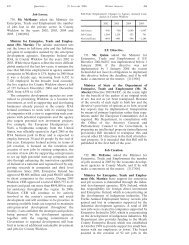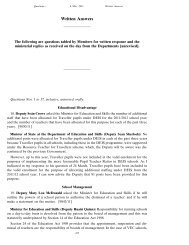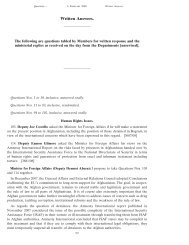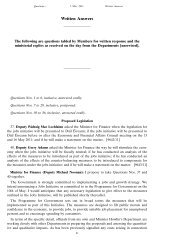Written Answers. - Parliamentary Debates - Houses of the Oireachtas
Written Answers. - Parliamentary Debates - Houses of the Oireachtas
Written Answers. - Parliamentary Debates - Houses of the Oireachtas
Create successful ePaper yourself
Turn your PDF publications into a flip-book with our unique Google optimized e-Paper software.
Questions— 14 February 2012. <strong>Written</strong> <strong>Answers</strong><br />
Education Welfare Service<br />
91. Deputy Thomas P. Broughan asked <strong>the</strong> Minister for Children and Youth Affairs if she<br />
will report on <strong>the</strong> operation <strong>of</strong> <strong>the</strong> National Education Welfare Board; <strong>the</strong> way <strong>the</strong> NEWB<br />
monitors and invigilates school attendance across <strong>the</strong> country; <strong>the</strong> number <strong>of</strong> staff in <strong>the</strong> NEWB<br />
that are assigned to this responsibility; if she will indicate <strong>the</strong> average absentee rate at primary<br />
and post-primary schools on a daily, weekly, monthly and yearly basis and on recent trends in<br />
those rates; and if she will make a statement on <strong>the</strong> matter. [7853/12]<br />
Minister for Children and Youth Affairs (Deputy Frances Fitzgerald): The complex issue <strong>of</strong><br />
school attendance is systematically addressed through <strong>the</strong> provisions <strong>of</strong> <strong>the</strong> Education<br />
(Welfare) Act, 2000. This act established <strong>the</strong> National Educational Welfare Board (NEWB) in<br />
2002 — mandating it with supervising and implementing <strong>the</strong> provisions <strong>of</strong> <strong>the</strong> Act to effectively<br />
ensure that ‘each child attends a recognised school or o<strong>the</strong>rwise receives a certain minimum<br />
education’ (Section 10). The legislation establishes a framework for promoting regular school<br />
attendance, participation and retention as well as tackling <strong>the</strong> manifold problems <strong>of</strong> absenteeism<br />
and early school leaving. The Act also charges <strong>the</strong> NEWB with responsibility for children<br />
who are being educated outside <strong>of</strong> recognised schools, for example at home, as well as 16-17<br />
year olds who leave school to take up employment.<br />
Since mid-2009 <strong>the</strong> Board has an expanded remit which includes responsibility for <strong>the</strong> Home<br />
School Community Liaison scheme and <strong>the</strong> School Completion Programme in addition to <strong>the</strong><br />
Educational Welfare Service. Under <strong>the</strong> extended remit, <strong>the</strong> Board is obliged to devise a single<br />
strategic approach to attendance, participation and retention. The Board is currently engaged<br />
in developing an integrated service model which would respond to <strong>the</strong> complexity <strong>of</strong> issues<br />
that impact on attendance, participation and retention. That model will be implemented in <strong>the</strong><br />
academic year 2012-2013. This implementation will include appropriate management information<br />
systems to capture data for <strong>the</strong> measuring and monitoring <strong>of</strong> outcomes.<br />
In relation to monitoring school attendance, <strong>the</strong> NEWB has 90 sanctioned Educational Welfare<br />
Service posts, 74 <strong>of</strong> which are currently filled (59 Educational Welfare Officers, 12 Senior<br />
Educational Welfare Officers and 3 Regional Managers). The Board also informs me that 2<br />
Educational Welfare Officers are due to retire at <strong>the</strong> end <strong>of</strong> <strong>the</strong> month.<br />
Since <strong>the</strong> commencement <strong>of</strong> <strong>the</strong> Education (Welfare) Act, 2000, schools are obliged to submit<br />
an Annual Attendance Report (“AAR”) to <strong>the</strong> NEWB on <strong>the</strong> levels <strong>of</strong> school attendance<br />
each year. An overall report derived from this data is produced by <strong>the</strong> Education Research<br />
Centre (ERC).<br />
I am advised by <strong>the</strong> Board that <strong>the</strong> data is not collected in such a way as to allow all <strong>the</strong><br />
breakdowns requested by <strong>the</strong> Deputy; I can, however provide <strong>the</strong> annual data from recent<br />
years as a significant indicator <strong>of</strong> non-attendance rates. In summary out <strong>of</strong> a primary student<br />
population <strong>of</strong> 424,138 students in 05/06 rising to 487,504 in 09/10 <strong>the</strong> number <strong>of</strong> days lost overall<br />
at primary level was 6.3% in 05/06, 6.2% in 06/07, 6.5% in 07/08, 6.3% in 08/09 and 6.2%<br />
in 09/10.<br />
Out <strong>of</strong> a post-primary student population <strong>of</strong> 271,349 students in 05/06 rising to 297,777 in<br />
09/10 <strong>the</strong> number <strong>of</strong> days lost overall at post-primary primary level was 7.8% in 05/06, 7.9% in<br />
06/07, 8.1% in 07/08, 8.3% in 08/09 and 7.9% in 09/10.<br />
Analysis <strong>of</strong> this data identifies key findings such as:<br />
— There has been <strong>the</strong> highest annual attendance returns ever to <strong>the</strong> NEWB from<br />
schools in 2009/10: 97% from Primary and 96% from Post Primary;<br />
336











![[Deputy Michael Noonan.]](https://img.yumpu.com/30494839/1/190x245/deputy-michael-noonan.jpg?quality=85)




